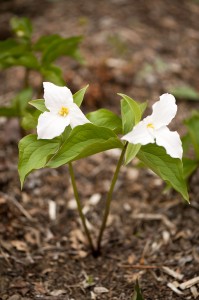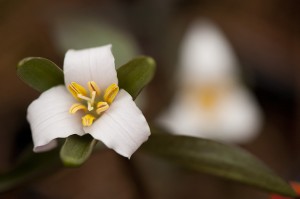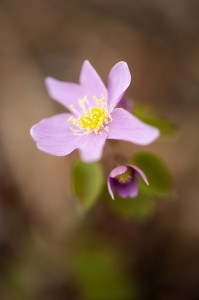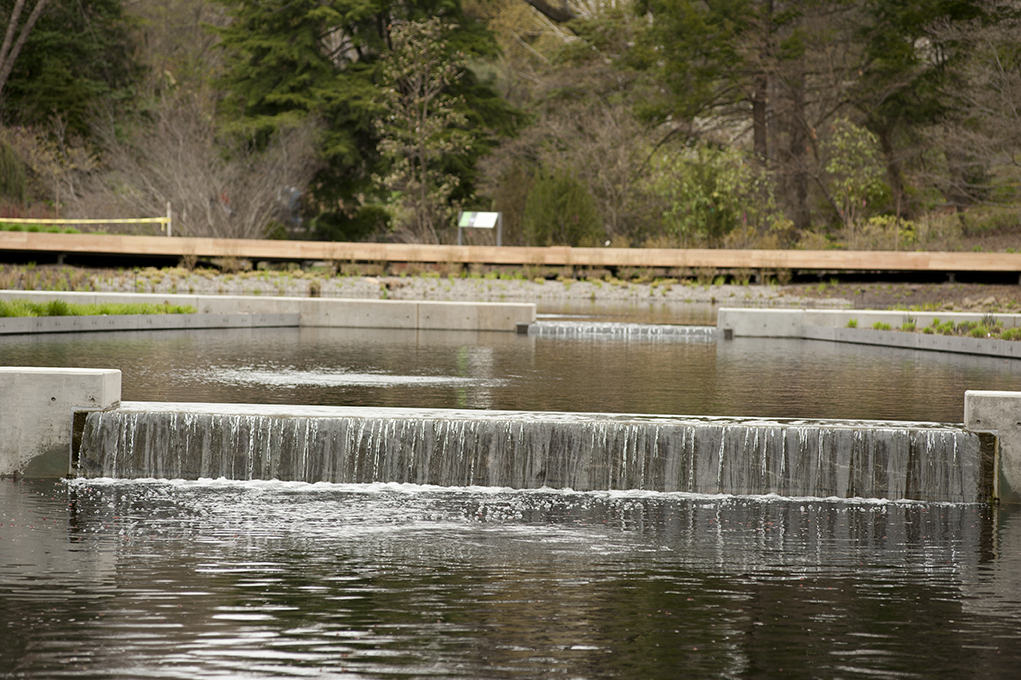Trillium and Other Native Beauties
Posted in Gardening Tips on April 30 2013, by Sonia Uyterhoeven
 I was out in the woodland area of our soon-to-open Native Plant Garden and found myself overwhelmed by the beauty of all the different species of trillium we have planted there. Trilliums bloom in early spring, taking advantage of the time on the forest floor before the trees grow leaves and cast shade upon them. Trilliums, much as their name might suggest operate in threes: three leaves, three sepals, and three petals. The leaves are arranged in whorls wrapping around the stem from a single point. The result is a graceful zygomatic symmetry. Triullums are undoubtedly one of the most showy and elegant trichotomous woodland native plants.
I was out in the woodland area of our soon-to-open Native Plant Garden and found myself overwhelmed by the beauty of all the different species of trillium we have planted there. Trilliums bloom in early spring, taking advantage of the time on the forest floor before the trees grow leaves and cast shade upon them. Trilliums, much as their name might suggest operate in threes: three leaves, three sepals, and three petals. The leaves are arranged in whorls wrapping around the stem from a single point. The result is a graceful zygomatic symmetry. Triullums are undoubtedly one of the most showy and elegant trichotomous woodland native plants.
There are two types of trillium, sessile and pedunculate. The flowers of sessile trilliums rest on the leaves without a flower stalk while pedunculate trillium flowers are elevated by a stalk. Sessile trillium tend to have mottled leaves that are spotted with silver or maroon coloring while pedunculate trillium have green foliage. Trilliums are slow to grow on their knobby rhizomes, but will slowly spread and form a nice clump, though it may take up to seven years before they flower if you plant them from seed. But, the pay-off is that once a clump is established in your garden it will live for decades.
My first stop was to see some transplanted yellow trillium, Trillium luteum, that my colleague John Egenes was anxious to look in on. John and Anne Hunter had transplanted them a few years ago, and we were happy to see them looking glorious nestled under a white oak, Quercus alba. Yellow trillium, a sessile trillium, is one of the most statuesque species we grow in the garden; it grows 14-16 inches tall. The yellow blooms have a light citrus scent and sit atop arresting, broad mottled foliage.
Close by the yellow trillium you will find toadshade, Trillium sessile, which is, as its name suggests, one of the stalkless trilliums. It grows 6-12 inches tall with rich burgundy petals that stay closed in an upright manner atop broad, mottled foliage. I remember years ago when I first met T. sessile at The New England Wild Flower Society, I said to my boss, “Lovely flower … When does it open?” Her answer: it doesn’t. Toadshade is planted in the Native Plant Garden amongst fine textured, fountain-like Appalachian sedge, Carex appalachica, and Brandywine foam flower, Tiarella cordifolia ‘Brandywine’.
A pedunculate trillium with an appearance similar to toadshade and bearing many monikers is Trillium erectum. Its common names include wake-robin, purple trillium, and stinking Benjamin. T. erectum appears in early spring, around the same time the robins return and has red flowers that are similar in hue to the robin’s red breast. They also smell rather bad, a ploy to attract carrion flies which pollinate them. But don’t worry too much about the smell, you really have to sink your nose into them to get a whiff. Purple trillium grows 7-16 inches tall, loves the acidic soil of the Northeast, and is one of the best clumping trilliums, making it an ideal starter trillium for the homeowner.
A showy trillium popular in the nursery trade, Trillium grandiflorum has large white flowers that fade to pretty pale pink. Known as the large-flowered trillium or white trillium T. grandiflorum will spread out into large clumps and is easy to grow. If you ever run across the double large-flowering trillium, Trillium grandiflorum forma polymerum ‘Flore Pleno,’ buy it. It is a naturally forming sport that has double flowers that look more like a gardenia than a trillium.
 Two other interesting trilliums can be found in the Native Plant Garden. Trillium flexipes, the bent trillium, is a pedunculate type with a white drooping flower that grows 12-18 inches tall. The darling Trillium pusillum ssp. alabamicum grows only 8 inches tall. The early blooming dwarf Alabama least trillium has white petals that change to pink as they age and is a diminutive beauty.
Two other interesting trilliums can be found in the Native Plant Garden. Trillium flexipes, the bent trillium, is a pedunculate type with a white drooping flower that grows 12-18 inches tall. The darling Trillium pusillum ssp. alabamicum grows only 8 inches tall. The early blooming dwarf Alabama least trillium has white petals that change to pink as they age and is a diminutive beauty.
If you are interested in growing trillium in your own garden, please make sure that you always buy only nursery grown plants, never wild-collected plants. Trillium like moist, well-drained soil and thrive in dappled shade. Give them a small amount of organic fertilizer in the spring and a light layer of mulch (shredded leaves are best for the woodland garden). Water trillium during the drier spells in the summer. There is a good chance the foliage will go dormant when the woodland gets dry. We plant our more established clumps approximately 6 inches in the ground and the smaller ones closer to 3 inches deep.
 It is not just trillium that you will find in the woodland garden part of the magnificent Native Plant Garden. You will also find Virginia bluebells, Mertensia virginica, in full bloom; cutie-pie rue-anemones, Anemonella; and double flowering bloodroot, Sanguinaria canadensis forma mutliplex (though early blooming bloodroot, S. canadensis are already gone).
It is not just trillium that you will find in the woodland garden part of the magnificent Native Plant Garden. You will also find Virginia bluebells, Mertensia virginica, in full bloom; cutie-pie rue-anemones, Anemonella; and double flowering bloodroot, Sanguinaria canadensis forma mutliplex (though early blooming bloodroot, S. canadensis are already gone).
To celebrate the grand opening of this spectacular new garden we are celebrating with two weekends of festivals! The first weekend, May 4-5 is dedicated solely to this beautiful new space, while the second weekend, May 11-12 is a celebration of Mother’s Day. We look forward to welcoming you and showing you around!


